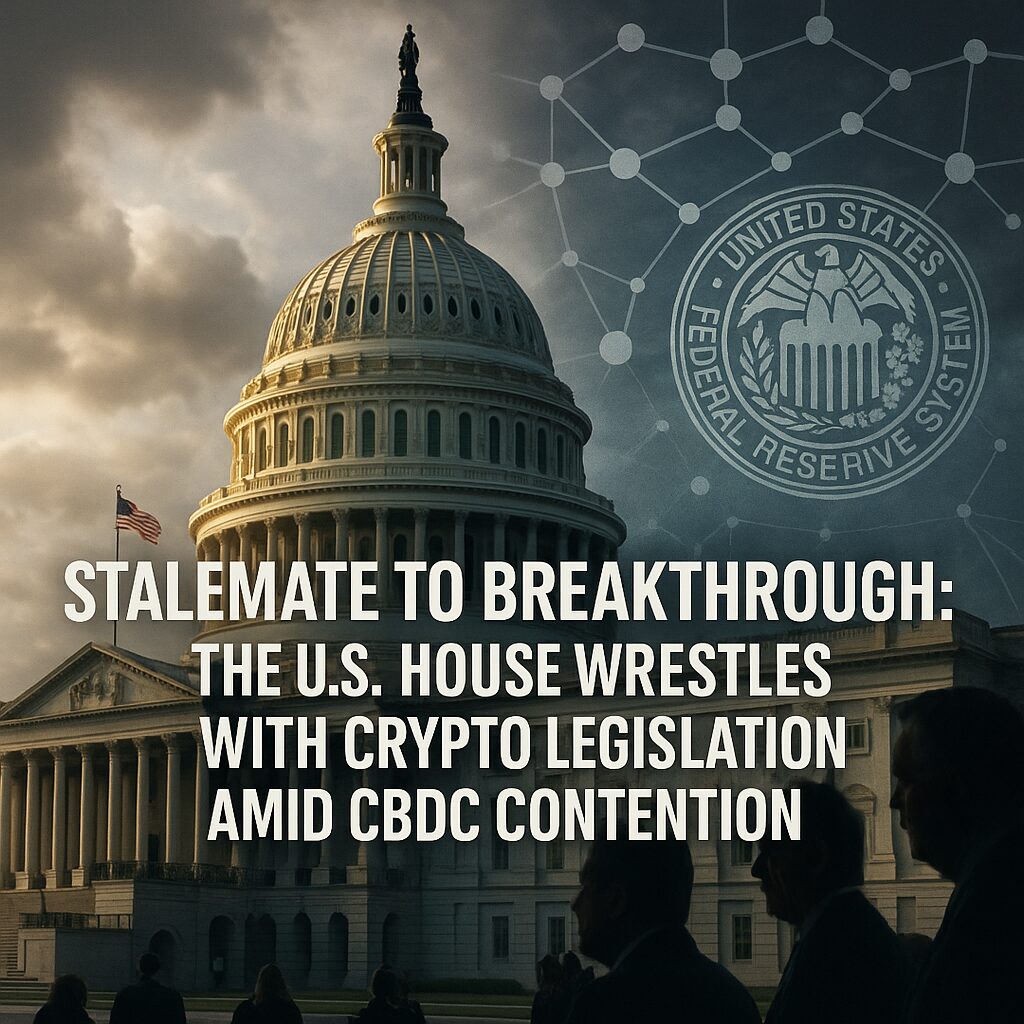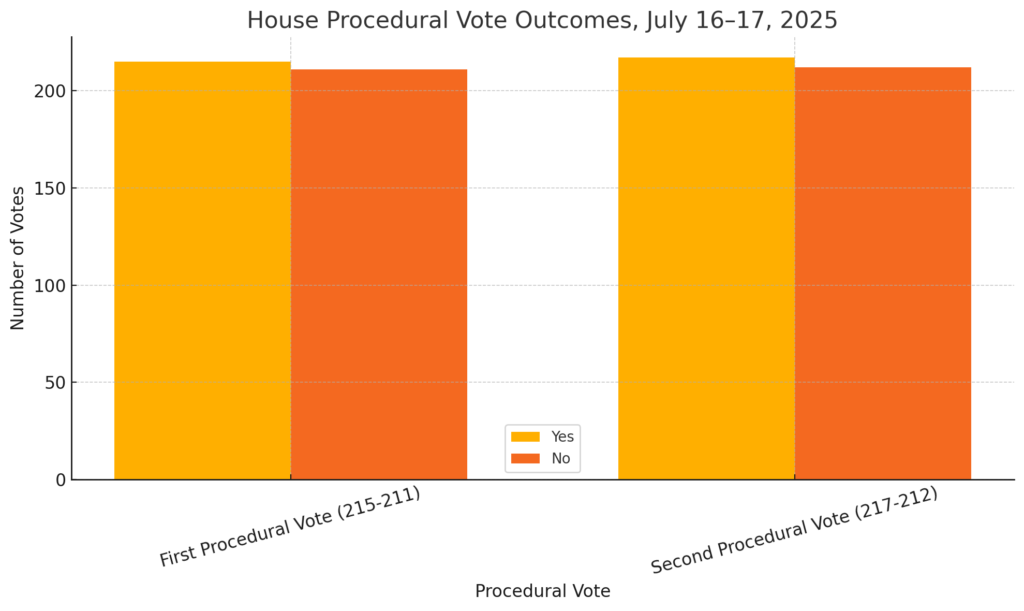
Key Takeaways:
- Procedural Delays and Narrow Margins
The House twice stalled on procedural votes before narrowly passing debate rules by 217–212, after an initial 215–211 approval. - Freedom Caucus Opposition
Hardline conservatives objected to what they deemed an insufficient ban on a Federal Reserve Digital Dollar (CBDC), demanding stronger language and integration with the CLARITY Act. - Trump’s Intervention and the NDAA Deal
President Trump brokered a last-minute agreement to attach the Anti-CBDC Surveillance State Act to the annual National Defense Authorization Act (NDAA), winning over eight holdouts for the second vote. - Path to Enactment
The GENIUS Act awaits a final floor vote and presidential signature, while the CLARITY Act and Anti-CBDC Act still require Senate consideration and may face further amendments. - Market and Regulatory Implications
Bitcoin briefly dipped to $115,967 before climbing back toward $118,660, reflecting investor jitters over legislative uncertainty.
1. Procedural Hurdles and Vote Outcomes
In mid-July 2025, the U.S. House’s ambitious “Crypto Week” agenda encountered dramatic stall outs on the floor. Under the guidance of House leadership, lawmakers sought to move three critical bills—the GENIUS Act (stablecoin framework), the CLARITY Act (market structure clarity), and the Anti-CBDC Surveillance State Act (banning Fed-issued digital currency)—through initial procedural votes setting debate terms.
- First Procedural Vote (July 16)
The first vote cleared debate rules by a razor-thin 215–211. However, objections from the House Freedom Caucus over the CBDC ban clause forced a second reconsideration. - Second Procedural Vote (July 17)
After intense closed-door negotiations, the House returned to the floor and passed the rules motion 217–212, securing the necessary support—including eight conservative holdouts—by agreeing to attach the CBDC ban to the NDAA.
Below is a visual breakdown of how the procedural votes unfolded:

Figure 1. House Procedural Vote Outcomes, July 16–17, 2025.
2. Freedom Caucus Resistance: CBDC Clause in Question
Members of the conservative House Freedom Caucus, led by Representatives Marjorie Taylor Greene and Chip Roy, argued that the Anti-CBDC Surveillance State Act’s prohibition on a central bank–issued digital currency was “too weak” and inadequately integrated with broader market-structure reforms. They demanded:
- Stronger, standalone CBDC ban language,
- A merged framework with the CLARITY Act, ensuring any future digital-dollar initiative faced robust safeguards.
This faction’s insistence on tightening the bill’s language triggered the need for a second procedural vote and intensified negotiations with GOP leaders.
3. Trump’s “Crypto Week” and the NDAA Compromise
President Trump, having declared this week “Crypto Week,” personally engaged with conservative holdouts on Tuesday evening. Sources report he promised to fold the Anti-CBDC Surveillance State Act into the NDAA—an annual must-pass defense spending bill—to placate concerns and guarantee its enforcement. In a statement, Trump remarked:
“These bills are critical for America’s leadership in digital finance. We’ll ensure no bureaucrat in the Federal Reserve can issue their own crypto dollar without Congress”—a nod to the negotiated NDAA attachment.
The deal’s mechanics mean the CBDC ban will be enacted under defense legislation, potentially insulating it from future procedural hurdles but tying its fate to broader defense funding negotiations.
4. The Legislative Roadmap Ahead
GENIUS Act
- Status: Passed the Senate 68–30 in June; House final vote imminent.
- Provisions: Uniform federal standards for stablecoin issuers, strict reserve requirements, reporting mandates.
- Next Steps: Expected to reach President Trump’s desk within days of House passage.
CLARITY Act
- Status: Still awaiting House floor consideration under the newly approved debate rules.
- Provisions: Defines digital assets as commodities under CFTC jurisdiction, offers legal certainty for tokens like BTC and ETH.
- Next Steps: Final House vote, then Senate review; potential amendments from conservative lawmakers.
Anti-CBDC Surveillance State Act
- Status: Now slated for inclusion in the NDAA.
- Provisions: Prohibits Federal Reserve issuance of a digital dollar without explicit congressional authorization.
- Next Steps: Passage of NDAA through both chambers and presidential signature.
5. Market and Industry Implications
The legislative twists significantly impacted market sentiment. On Tuesday, Bitcoin dipped to $115,967 amid uncertainty, then rebounded toward $118,660 after reports of renewed momentum. Ether also saw volatile swings, rising nearly 7% following favorable talk of stablecoin regulation.
Industry Perspectives:
- Cameron Winklevoss, co-CEO of a major exchange, commented: “Clear rules on stablecoins and definitive market-structure guardrails will unleash new institutional capital.”
- Jerome Powell, Fed Chair, reiterated that “the Federal Reserve will not issue a CBDC absent congressional authorization,” aligning with the congressional ban clause.
Market analysts note that established regulatory clarity could catalyze broader institutional participation, while the CBDC ban signals bipartisan wariness of a Fed-issued digital currency.
6. Conclusion
After a roller-coaster of procedural votes, high-stakes negotiations, and presidential intervention, the U.S. House has finally set the stage for landmark crypto legislation. The GENIUS Act now appears poised for near–term enactment, promising a federal stablecoin framework measured in $ billions in market capitalization. Meanwhile, the CLARITY Act’s path is clearer but not yet assured, and the CBDC ban’s hitch to the NDAA illustrates the complex interplay of defense and digital-financial policy.
For investors and blockchain practitioners, the takeaway is unequivocal: Washington is moving fast to codify the rules of the road for digital assets. As these bills advance, market participants should prepare for a new era of regulatory certainty—and ensure their strategies align with both the opportunities and constraints that federal policy will impose.

